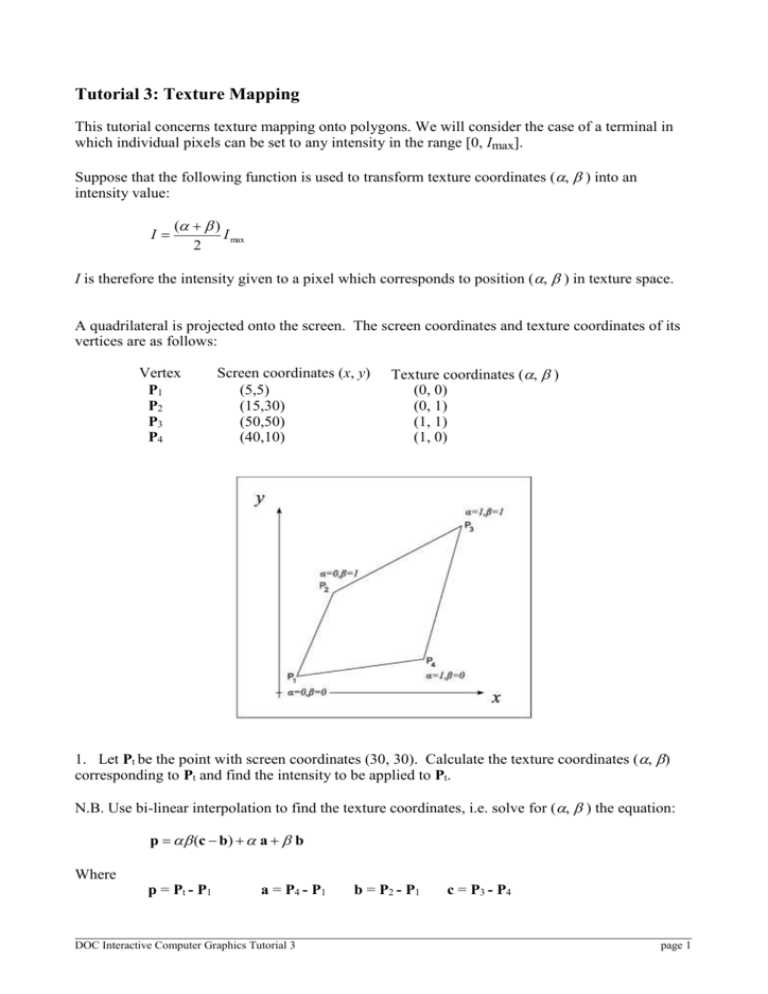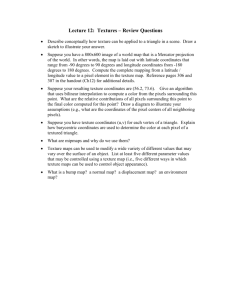GraphicsTutorial03
advertisement

Tutorial 3: Texture Mapping This tutorial concerns texture mapping onto polygons. We will consider the case of a terminal in which individual pixels can be set to any intensity in the range [0, Imax]. Suppose that the following function is used to transform texture coordinates (, ) into an intensity value: I ( ) I max 2 I is therefore the intensity given to a pixel which corresponds to position (, ) in texture space. A quadrilateral is projected onto the screen. The screen coordinates and texture coordinates of its vertices are as follows: Vertex P1 P2 P3 P4 Screen coordinates (x, y) (5,5) (15,30) (50,50) (40,10) Texture coordinates (, ) (0, 0) (0, 1) (1, 1) (1, 0) 1. Let Pt be the point with screen coordinates (30, 30). Calculate the texture coordinates (, ) corresponding to Pt and find the intensity to be applied to Pt. N.B. Use bi-linear interpolation to find the texture coordinates, i.e. solve for (, ) the equation: p (c b) a b Where p = Pt - P1 a = P4 - P1 DOC Interactive Computer Graphics Tutorial 3 b = P2 - P1 c = P3 - P4 page 1 Computing texture coordinates for every pixel by using bi-linear interpolation is very time consuming, since the solution of a quadratic is required. By doing the calculations differentially, much computation time can be saved. For example, consider the line from P1 to P2: At P1 = 0 and at P2 = 1 and there are 26 pixels on the line (the biggest change in the screen coordinates is along the y-component, from 5 to 30, which gives 26 pixels including the end-points). Moving along the line from P1 to P2, the differential change in from one pixel to the next is 1 because 26 pixels (including end-points) have 25 spaces between them. 25 Thus, we can estimate the values of at each pixel along the line simply by adding the differential as we move from one pixel to its neighbour. 2. What are the differentials in and for the four lines bounding the quadrilateral? 3. Now consider the horizontal line through the point (30, 30). Using the differential method above, find the values of and at the points where it intersects the sides of the quadrilateral, and hence find the differentials in and along the line. 4. Use these differential values to compute and at the point (30, 30). Find also the corresponding intensity to be given to the pixel. Compare your results with the values obtained in part 1. 5. Can you suggest why the methods in parts 1 and 3 do not give exactly the same result? Notice that with the differential method, calculating and for most of the pixels in the quadrilateral requires only two additions, and hence is much faster. DOC Interactive Computer Graphics Tutorial 3 page 2 Tutorial 3: Texture Mapping Solutions Q1. Using the notation in the notes and writing vectors as columns, we have the following edge vectors for three of the quadrilateral’s edges: 35 a P4 P1 5 10 b P2 P1 25 10 c P3 P4 40 25 p Pt P1 25 The vector equation p (c b) a b can therefore be written: 25 10 10 35 10 25 40 25 5 25 Simplifying and separating the components, we obtain two equations 25 0 35 10 25 15 5 25 Which can be simplified to 7 2 3 5 5 5 5 7 which can be substituted into the second to obtain 2 5 7 5 7 3 5 5 2 2 The first equation gives 21 2 18 15 0 7 2 6 5 0 0.52 or -1.38 Ignoring the negative value of , we have 0.52 and 0.68 0.5 (5 7 0.52) . The intensity value to be given to the pixel should therefore be I (0.52 0.68) I max 0.6 I max 2 DOC Interactive Computer Graphics Tutorial 3 page 3 Q2. The differentials of and along the for lines are as follows: x-change y-change No. Of pixels P2 10 25 26 0 P2 P3 35 20 36 1 P1 P4 35 5 36 1 P4 P3 10 40 41 Start End P1 1 25 35 0 35 0 0 1 40 Q3. The horizontal line through Pt intersects the quadrilateral at two locations. One intersection is at the point (15, 30) which is the vertex P2, and has = 0, = 1. The other intersection is half way along the line from P4 to P3 and has = 1, = 0.5. Since the pixel coordinate of the second intersection is (45, 30), the horizontal line has 31 pixels. The differentials of and along the horizontal line are therefore: 1 0 1 30 30 0.5 1 1 60 30 Q4. The pixel at Pt is the 16th along the horizontal line. Its and values are therefore given by: = 0 + 15 = 0.5 = 1 + 15 = 0.75 The intensity given to the pixel based on these texture coordinates is therefore I (0.5 0.75) I max 0.625 I max 2 DOC Interactive Computer Graphics Tutorial 3 page 4 Q5. To compute the values of and along the sides of the quadrilateral the differential method uses linear interpolation, and since in every case one or other of the texture coordinates is a constant along each edge, the bi-linear interpolation equation reduces to a linear equation. Hence these values on the edges given by the differential method and the bi-linear interpolation method are the same. However, along the horizontal line, both and vary and y is fixed. Thus the term in the interpolation equation remains, giving a 2nd order relationship of the form: x K1 2 K 2 K 3 and x L1 2 L2 L3 Hence, linear interpolation will not give the same result along the line. In practice, the differences will be small if the edge vectors b and c are similar. DOC Interactive Computer Graphics Tutorial 3 page 5







